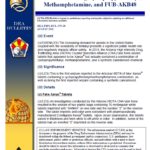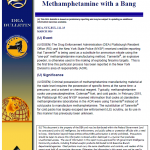The growing popularity of methamphetamine over the past 15 years has increased the risk of exposure to the surrounding community and law enforcements personnel. Methamphetamine is a controlled substance that is “cooked” using many common household ingredients which can be volatile and generates by‐products that can be very harmful to humans. When these products are combined, they emit toxic fumes and may cause chemical burns upon contact. Toxic residue from the cooking process saturates every surface and can remain there for months or years if not properly sterilized. Since the chemicals can be inhaled, ingested, or absorbed through the skin, everyone coming in contact with those surfaces is vulnerable. Acute exposure occurs over a relatively short time and produces symptoms that include: shortness of breath, cough, chest pain, dizziness, lack of coordination, chemical irritation, and burns to the skin, eyes, nose, or mouth. If toxicity levels are fairly high or a person is particularly vulnerable (i.e. pre‐existing breathing problems), acute exposure can cause death. Less significant exposure can result in headaches, nausea, dizziness, fatigue, or lethargy, and can lead to other long‐term health problems.
Read more →


